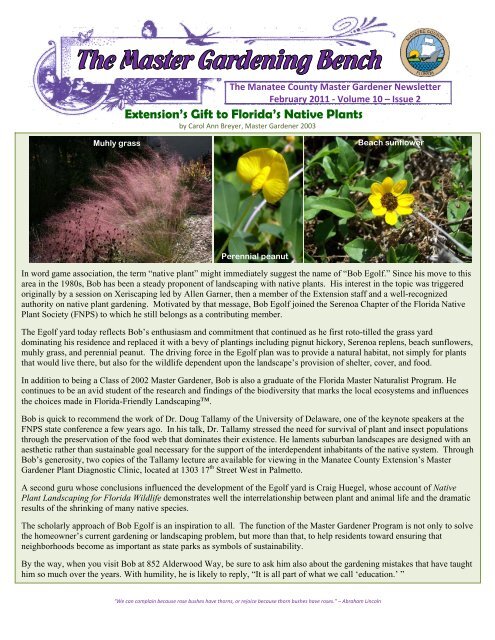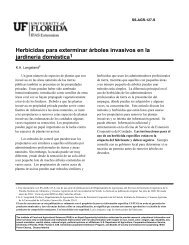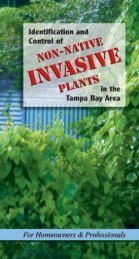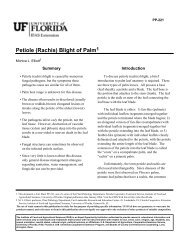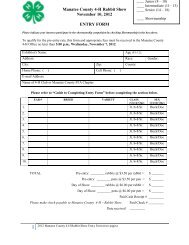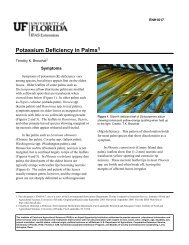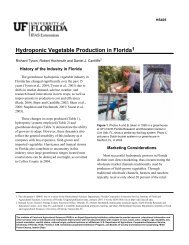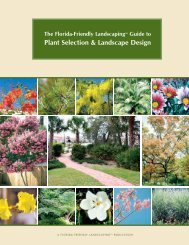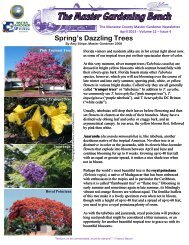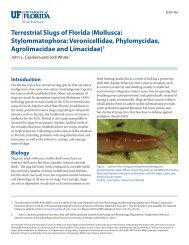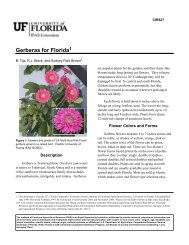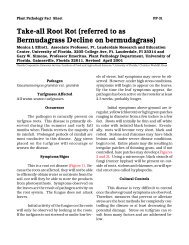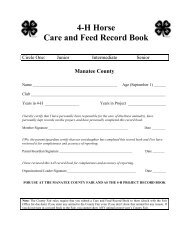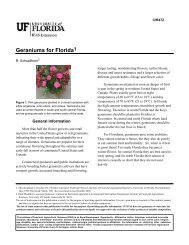Extension's Gift To Florida's Native Plants - Manatee County ...
Extension's Gift To Florida's Native Plants - Manatee County ...
Extension's Gift To Florida's Native Plants - Manatee County ...
You also want an ePaper? Increase the reach of your titles
YUMPU automatically turns print PDFs into web optimized ePapers that Google loves.
The <strong>Manatee</strong> <strong>County</strong> Master Gardener NewsletterFebruary 2011 ‐ Volume 10 – Issue 2Extension’s <strong>Gift</strong> to Florida’s <strong>Native</strong> <strong>Plants</strong>by Carol Ann Breyer, Master Gardener 2003Muhly grassBeach sunflowerPerennial peanutIn word game association, the term “native plant” might immediately suggest the name of “Bob Egolf.” Since his move to thisarea in the 1980s, Bob has been a steady proponent of landscaping with native plants. His interest in the topic was triggeredoriginally by a session on Xeriscaping led by Allen Garner, then a member of the Extension staff and a well-recognizedauthority on native plant gardening. Motivated by that message, Bob Egolf joined the Serenoa Chapter of the Florida <strong>Native</strong>Plant Society (FNPS) to which he still belongs as a contributing member.The Egolf yard today reflects Bob’s enthusiasm and commitment that continued as he first roto-tilled the grass yarddominating his residence and replaced it with a bevy of plantings including pignut hickory, Serenoa replens, beach sunflowers,muhly grass, and perennial peanut. The driving force in the Egolf plan was to provide a natural habitat, not simply for plantsthat would live there, but also for the wildlife dependent upon the landscape’s provision of shelter, cover, and food.In addition to being a Class of 2002 Master Gardener, Bob is also a graduate of the Florida Master Naturalist Program. Hecontinues to be an avid student of the research and findings of the biodiversity that marks the local ecosystems and influencesthe choices made in Florida-Friendly Landscaping.Bob is quick to recommend the work of Dr. Doug Tallamy of the University of Delaware, one of the keynote speakers at theFNPS state conference a few years ago. In his talk, Dr. Tallamy stressed the need for survival of plant and insect populationsthrough the preservation of the food web that dominates their existence. He laments suburban landscapes are designed with anaesthetic rather than sustainable goal necessary for the support of the interdependent inhabitants of the native system. ThroughBob’s generosity, two copies of the Tallamy lecture are available for viewing in the <strong>Manatee</strong> <strong>County</strong> Extension’s MasterGardener Plant Diagnostic Clinic, located at 1303 17 th Street West in Palmetto.A second guru whose conclusions influenced the development of the Egolf yard is Craig Huegel, whose account of <strong>Native</strong>Plant Landscaping for Florida Wildlife demonstrates well the interrelationship between plant and animal life and the dramaticresults of the shrinking of many native species.The scholarly approach of Bob Egolf is an inspiration to all. The function of the Master Gardener Program is not only to solvethe homeowner’s current gardening or landscaping problem, but more than that, to help residents toward ensuring thatneighborhoods become as important as state parks as symbols of sustainability.By the way, when you visit Bob at 852 Alderwood Way, be sure to ask him also about the gardening mistakes that have taughthim so much over the years. With humility, he is likely to reply, “It is all part of what we call ‘education.’ ”“We can complain because rose bushes have thorns, or rejoice because thorn bushes have roses.” – Abraham Lincoln
<strong>Manatee</strong> <strong>County</strong> Extension1303 17 th Street West - Palmetto, FL 34221Telephone: (941) 722-4524http://manatee.ifas.ufl.eduMaster Gardeners Amy Stripe & Joy Derksen, Co-editorsContents reviewed & edited by Lisa Hickey, Extension Agent.Send a photo or gardening problem via email to the Master Gardenersat <strong>Manatee</strong>MG@gmail.com or visit them at the <strong>County</strong> Extension OfficeMonday – Friday 9:00 a.m. to 4:00 p.m., except closed on Wednesday.Houseplant Pestsby Amy Stripe, Master Gardener 2008Mealy BugsMost common pests that prey on houseplants are fairly easily detected.Mealybugs are small (1/5‐1/4 in. long), soft‐bodied insects with acottony appearance that cause leaf yellowing and hinder growth. Aphidsare pear shaped, measure 1/25‐1/8 in. long, and line up in groups onnew growth, curling and distorting leaves. Scale insects vary from 1/8‐1/3 in. long, can be almost any colorand are surrounded by a circular oroblong waxy covering when mature.Scale insects would be found on both sides of leaves, twigs and branches, willreduce growth, and cause leaf drop and yellow spots on tops of leaves. At 1/16in. long, whitefly resembles a minute moth and inhabits the undersides of leaveswhich make it difficult to detect ‐ unless you disturb the plant, causing a swarm.This pest saps plant vigor. All of the above insects secrete a sticky substancecalled “honeydew” upon which sooty mold (a velvety black fungus) thrives. This isa surefire sign that you’ve got an infestation.The most difficult of the common pests to detect may be the spider mite, asometimes colorless, virtually microscopic bug that infests the undersides ofleaves, giving the upper side a spotted look. Apart from this symptom, thepresence of fine webbing on the leaves is another sign.AphidsAphids and mealybugs canbe removed with a cottonswab dipped in alcohol; don’t overdo it, though, as alcohol canburn foliage. Washing foliage in soapy water (2 tsp. of nondegreasingdishwashing detergent per gallon of water) willremove aphids, mealybugs and scale insects. If bigger guns arecalled for, use a commercial horticultural oil (such as neem),which will be effective on all five of these pests, or insecticidalsoap, also effective on all (but only the immature stage of scaleinsects). Be sure the product is specifically labeled forhouseplants. General household pesticides (for cockroaches orflies) should not be used as they may damage the foliage. Followpackage instructions carefully and take plants outside to apply.WhitefliesPage 2
Spider MitesPrevention is easier than the cure. Before bringing any plant into yourhome, inspect it carefully. Keep it isolated from your otherhouseplants for several weeks. A good cultural practice is to spraytops and bottoms of foliage with a strong stream of water (in theshower, laundry sink, or outside with a hose) every two weeks toremove dust and many insects before they get a toehold.Remember thatmany of the mostpopular houseplantsare natives of thehumid, shadyundertstories of hottropical forests. Thisincludes the dieffenbachia, schefflera, philodendron, pothos, croton,ficus, peace lily, Chinese evergreen, peperomia, Boston fern,dracaena, and Swiss cheese plant. The most difficult environmentaltropical condition to replicate in your home may be humidity (mosthouseholds are much lower than the 40 to 60 percent mosthouseplants need, especially during winter months when heating isScale Insectson.) Spider mites in particular attack plants suffering from lowhumidity, so in addition to proper lighting, feeding, watering and temperature (don’t put plants in drafts fromwindows or vents), periodic misting or placing pots on wet gravel beds will help with humidity.For more on houseplant pest control visit http://edis.ifas.ufl.edu/mg004 . For more on caring for houseplants go tohttp://edis.ifas.ufl.edu/mg031Maintaining and Sanitizing Your Garden <strong>To</strong>olsBy John Dawson, Master Gardener 2007"If you take care of your tools they'll take care of you" is an old and proven saying. The secret to havinggarden tools you can count on year after year is to buy the best quality tools you can afford and then maintainthem. If you do those two things, your children and grandchildren will be using your garden tools long afteryou've stopped gardening.The main enemies of all garden tools are moisture (causes rust), improper use, and poor or inadequatemaintenance. <strong>To</strong> keep your gardening tools around for a long time:• Clean your tools after each use and put them where theybelong.• Store your tools off the ground in a dry place.• Remove any rust that forms on a tool and coat with oil.• Keep wooden handles smooth by sanding and oiling them.• Spray fiberglass handles with a clear enamel to preventfraying.• Keep cutting edges sharp and moving points oiled.• Use the right tool for the job.• Use the tool as it was intended.• Replace/repair badly damaged tools.Poor Storage & MaintenancePage 3
Sharpening Cutting <strong>To</strong>olsAll tools must be clean before sharpening. Knock off all dirt, wash, rinse, and wipe dry. Use steel wool, awire brush/wheel, SOS soap pads or light sandpaper to scour blades of rust. Scissors, snips, shears, mowerblades, pruners and loppers are all sharpened the same way. If possible, disassemble the blades and secure ina vise. Once removed, the cutting blade edge can be sharpened using a bastard file, whetstone or even akitchen knife sharpener. Always file in one direction away from you. Adjust your angle as needed to file theentire edge evenly on the factory bevel; usually 10 strokes will expose clean metal over the entire edge. Dothe same with the other blade, and never use small jerky strokes because it will cause you to lose the factoryedge. The flat edge, where the blades come together, should be filed or sanded to remove any burrs. Use 300wet/dry sandpaper or a honing stone, keep the blade flat and file/sand in a circular motion and check forburrs. <strong>To</strong> finish, lightly oil all surfaces (WD-40 works well) and reassemble the tool.Proper Sharpening TechniqueSanitizing Cutting <strong>To</strong>olsWhen sharpening a shovel (yes, it’s a cutting tool), only sharpen the upper edge of the shovel. Astraightforward way to do this is to fasten the shovel into a large vise with the head near the vise and facingup. Start at one side of the shovel base and, holding a bastard file at a 45-degree angle to the edge of theshovel and pointing inwards towards the center, make four or five even strokes inward and upward. Stepyour file an inch or two towards the tip and repeat the motions until you get to the tip of the shovel. Repeatfor the other half. Sharpen hoes the same way. Hatchets and axes need to have both sides of the bladesharpened at a 45-degree angle. Saws, chain saws, and powered hedge trimmer blades require specialhandling and different files to maintain a factory bevel and the technique is too complicated for this article.All metal tools should be cleaned and oiled before storage. I prefer to use WD-40 because not only does itpenetrate and lubricate, it also displaces water. The WD actually stands for Water Displacement.Sanitizing <strong>To</strong>olsPlant diseases can be carried from plant to plant by your hands, pruning tools, saws, and shovels. All shouldbe disinfected between plant specimens if you suspect a disease problem in your landscape. In general,washing with detergent (not soap) works fine. If you suspect diseased plants or want to be sure not to infecthighly priced or prized plants, you may want to take further precautions. For cutting tools, a 20-30% (1 cupdisinfectant to 3 to 5 cups water) solution of household bleach or pine oil product, makes a good simpledisinfectant. Rubbing alcohol (70% denatured alcohol) from the drug store will also work, as will tri-sodiumphosphate (TSP) available from orchid supply stores and web sites. Soak the tool at least 5 minutes, and thenrinse with clean water, wipe with a clean towel or allow to air dry. Denatured alcohol (available as shellacthinner) and Pine Sol (19.9% pine oil) are effective when used full strength, but are very corrosive to tools, sobe sure to rinse thoroughly and oil the tools after use to prevent rusting. Washing your hands with soap underrunning water and using a hand sanitizer or an alcoholic wipe is all that is necessary to clean your handsbefore or after working with diseased plant material. In general, plant pathogens are not harmful to humans.Page 4
Saturday, February 12 th 9:30 – 11:30 a.m.Backyard Beekeeping WorkshopGuest speaker Kevin Lossman, President of the Suncoast Beekeepers Group,will be teaching how to invite honeybees to your landscape. <strong>To</strong>pics that willbe covered: what you need to encourage bees to your yard, fundamentals tostarting a hive in your backyard, what basic equipment you will need to startbeekeeping, UF Master Beekeepers course, and awareness of the AfricanizedHoneybees. Please call 941-722-4524 and ask a Master Gardener to registeryou for the class or register online at http://manatee.ifas.ufl.edu .TOMATO GROWING TIPSby Charlie Luce, Master Gardener 2005Who wants to grow tomatoes in Florida? We are a nationwide leader in growing this delicious relative of the pepper,potato, and eggplant. It also happens to be our state’s most important commercial vegetable, so why grow your own?The answer? You like to garden for the fun of it, to get outside in the sunshine, and to taste them while they are stillwarm right off the vine. Here are some growing tips:<strong>To</strong>matoes can be started from seeds or from transplanting seedlings. They can be grown in rows in the garden, aflowerbed, or in most containers with good water drainage. Have the soil tested by the Extension Office or UF, as theygrow best if the pH is between 6.2 and 6.5.Timing is critical. <strong>To</strong>matoes are easily injured or killed by frost so be prepared to cover them or move theminside should the danger of frost develop. Temperatures and humidity that are too high will interfere withpollination and fruit set. So plant January-March for a spring harvest and no later than Labor Day for the fall.Seeding can be done most anytime, but transplanting should be done on a cloudy day or in the evening. Shadethe seedlings for several days in order to allow them a chance to get set up, because a day of hot sun can do themin. Transplants should be planted 1 to 2 inches deeper than they were in the pot, and a pint of starter fertilizermade of 6-6-6 or 6-8-6 given to each plant is beneficial.If we have no rain, give tomatoes a heavy soaking once a week (versus frequent, light watering) and considerusing a drip feeding system to save water and keep foliage from getting wet. Wet foliage can set up disease.Remove suckers (small side branches) so that only one or two main stems develop. This will decrease thenumber of fruits produced, but increase the size of those remaining.Mulch the plants with grass clippings, straw, or leaves as this will help keep the soil moist and the weeds down.Scout at least twice a week for signs of insects, diseases, nematodes, and other problems. Look under leaves andthe developing fruit. Ask your Extension Service for help in diagnosing problems before applying chemicalcontrols.As for the best varieties to grow, that is up to you. However, try to pick varieties that are resistant to Fusarium wilt, leafspot, leaf mold, early blight, and gray wall. There are staked (indeterminate) large fruit and small fruit; bush type andsemi-vining (determinate) large fruit and small fruit; extra large; and heirlooms. For the particulars on these varietiesand other growing information, go online to http://edis.ifas.ufl.edu/vh028 . Good luck, good growing and happy eating.Page 5
Date Time Event2 nd & 4 th Saturday 10:00 a.m.–1:00 p.m.Rocky Bluff Branch Library – 7016 US Highway 301, Ellenton – Visit the Master Gardener information table outsidethe library and get answers to your gardening questions.February 2 1:30–4:00 p.m.Landscaping on Reduced Water Use – An introduction to micro‐irrigation. Learn how to select, install, andoperate your own water‐saving irrigation system. Pros and cons, parts and pieces and what things are called.Presented by Jack Tichenor, Water Conservation Agent. Register online at http://manatee.ifas.ufl.edu or callCheryl at 722‐4524.February 3 1:00–3:00 p.m.Rain Barrel Workshop – Held at the Braden River Library, 4915 53 rd Avenue East Bradenton. Learn how to install,paint, and maintain a functional rain barrel. Register at http://manatee.ifas.ufl.edu or call Cindy at 722‐4524.February 8 10:30 a.m.–12:00 p.m.Compost Workshop – Held at the Rocky Bluff Library, 7016 US Highway 301 N., Ellenton. Learn how to turn yourkitchen scraps and yard waste into useful soil amendments, learn Florida‐Friendly Landscaping concepts andhow to set up a home compost bin. Register at http://manatee.ifas.ufl.edu or call Cindy at 722‐4524.February 8 2:00–4:30 p.m.The Lowdown on Lawn Irrigation – This class to be held at the Peridia Golf and Country Club in the CommunityBldg., 4950 Peridia Blvd., E. Bradenton. Learn how to adjust the timer and sprinklers, improve uniformity,eliminate water waste, and cut costs. A free lawn sprinkler tune up kit will be given to each attendee. This classsatisfies the irrigation education portion of the <strong>Manatee</strong> <strong>County</strong> Water Conservation Rebate Program. Presentedby Jack Tichenor, Water Conservation Agent. Register at http://manatee.ifas.ufl.edu or call Cheryl at 722‐4524.February 9 10:00 a.m.–12:00 p.m.Cooking with Herbs – Throw that salt shaker away! Come learn about different kinds of herbs and how to usethem to spice up your life. <strong>To</strong>pics include selecting, drying, storing, and meal preparation. Presented by SamanthaKennedy, Extension Agent. Register online at http://manatee.ifas.ufl.edu or call Samantha at 722‐4524.February 9 1:00–4:00 p.m.Spring Vegetable Gardening & Alternative Organic Gardening with Aeroponics – Learn the basics on how to startand what to plant for a spring vegetable garden. The basics include soil dynamics, pest and disease pointers, andcorrect fertilizer applications for the most fruitful yield. Aeroponics is the new “Hydroponics.” Presented by LisaHickey, Extension Agent. Register at http://manatee.ifas.ufl.edu or call the Master Gardeners at 722‐4524.February 12 9:00–11:00 a.m.Plant ID & Nature <strong>To</strong>ur Riverview Preserve ‐ (next to DeSoto National Memorial Park) Stroll through this preservewith a Master Gardener volunteer to learn about Florida’s native plants and inhabitants of a coastal habitat.Program suitable for all ages. Call the Master Gardeners at 722‐4524 to register.February 12 9:30‐11:30 a.m.Backyard Beekeeping – Provides tips on how to start backyard beekeeping, safety concerns and awareness ofAfricanized Honey Bees, and the importance of the pollinators. Presented by Kevin Lossman local beekeeper.Register online http://manatee.ifas.ufl.edu or call the Master Gardeners at 722‐4524.February 15 2:00–4:30 p.m.Peridia – Water Wise Landscapes – This class satisfies the landscape portion of the <strong>Manatee</strong> <strong>County</strong> WaterConservation Rebate Program. Even in Florida, the key to smart landscaping is to develop a landscape to savemoney, energy, water, and time. Learn practical design tips, landscape pitfalls, garden chores, hardscape choices,texture combinations and remedies for difficult areas. If you need an ID of a plant, arrive early to class and bring along branch with leaves (ideally with flower or seed). Presented by Elissa Mirabelli, Horticulture ProgramAssistant. Register at http://manatee.ifas.ufl.edu or call Elissa at 722‐4524. *This class held at the Peridia Golf &Country Club’s Community Building, 4950 Peridia Blvd. E, Bradenton.February 19 9:00–11:00 a.m.Plant ID & Nature <strong>To</strong>ur at Emerson Point Preserve ‐ Stroll through Emerson Point Preserve with a MasterGardener volunteer to learn more about Florida’s native plants and inhabitants of a coastal habitat. This program issuitable for all ages. Call the Master Gardener Office at 722‐4524 to register.February 19 & 2029 th Annual Cortez Commercial Fishing Festival – Family fun‐filled event. Music, dancing, nautical arts and crafts,10:00 a.m.–6:00 p.m.seafood and more. Come learn more about the fishing heritage of Cortez. All proceeds to go towards expansionBoth Daysand restoration of the FISH Preserve. Festival at 4415 119 th St. W., Bradenton, also known as the Village of Cortez.February 20 9:00‐11:00 a.m.Plant ID & Nature <strong>To</strong>ur at Robinson Preserve – Stroll through the Robinson Preserve’s salt marshes with a MasterGardener volunteer to learn more about Florida’s native plants and inhabitants of a coastal habitat. This programis suitable for all ages. <strong>To</strong> register call the Master Gardener Office at 722‐4524.February 21 <strong>County</strong> Offices Closed In observance of President’s Day HolidayFebruary 27 9:00–11:00 a.m.Plant ID & Nature <strong>To</strong>ur – Rye Preserve ‐ Stroll through Rye Preserve with Master Gardener and Master NaturalistBob Egolf to learn what grows in a dry, sandy upland habitat. He will lead this new tour through the scrubs andpointing out the native wildflowers and shrubs. Call the Master Gardeners at 722‐4524 to register.<strong>Manatee</strong> <strong>County</strong> Extension Service ‐ Department of Agriculture and Resource Conservationlocated at 1303 17 th St. W., Palmetto, FL 34221 Telephone: 941‐722‐4524 Web site: http://manatee.ifas.ufl.edu E‐mail: manateemg@gmail.comThe Institute of Food and Agricultural Sciences (IFAS) is an Equal Opportunity Institution authorized to provide research, educational information, and other services only to individuals and institutions that function with non‐discrimination with respect to race, creed, color, religion, age,disability, sex, sexual orientation, marital status, national origin, political opinions, or affiliations.


